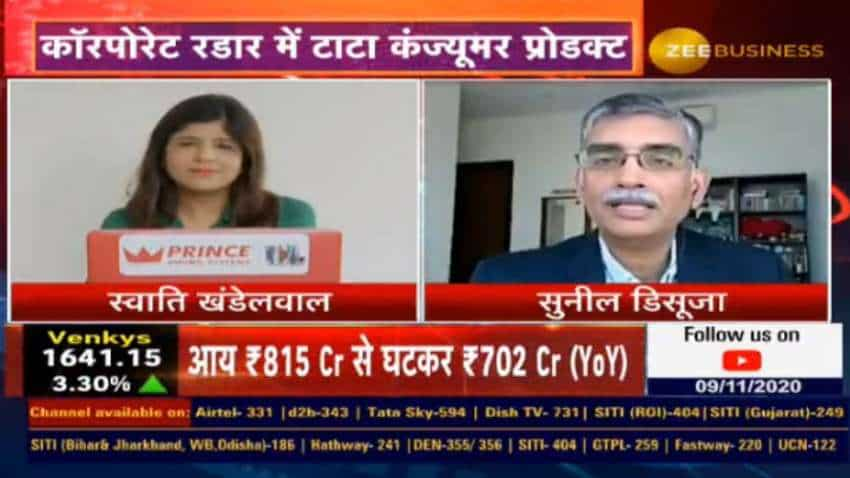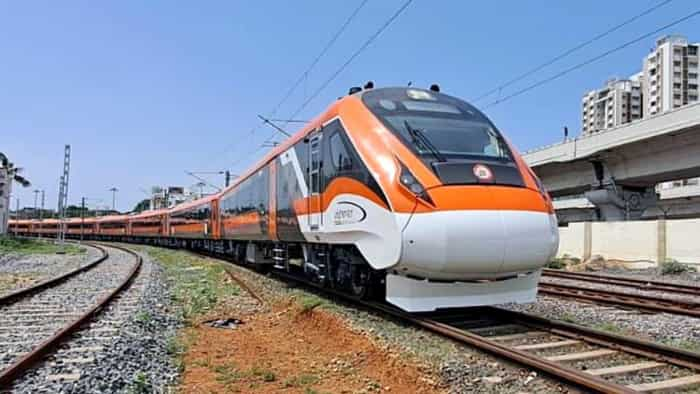Our market share has increased in Tea and Salt segment: Sunil D'Souza. CEO & MD, Tata Consumer Products
Sunil D'Souza, CEO & Managing Director, Tata Consumer Products, talks September quarter numbers, Tea and coffee prices, tea and salt business, food business, the digital play of the company among others and integration of the food and beverage business during a candid talk with Swati Khandelwal.

Sunil D'Souza, CEO & Managing Director, Tata Consumer Products, talks September quarter numbers, Tea and coffee prices, tea and salt business, food business, the digital play of the company among others and integration of the food and beverage business during a candid talk with Swati Khandelwal, Zee Business. Edited Excerpts:
Q: Congratulation of the good set of numbers in September quarter. India business has contributed strongly to the overall numbers. Tell us the segments that contributed the most and what challenges you are facing in the context of the international business?
A: As far as results are concerned then every business that we have - whether India beverages, India foods, international – has performed well in this quarter. India beverages have grown 32%, India Foods grew 13% and International has shown a growth of 7% in the top line. But, if I have a look at the bottom line then India beverages has grown 33%, India Foods has grown 36% and international about which you have talked about has grown 36%. So all-in-all, it is a good performance across various businesses. India beverages revenue is far ahead of volume because the tea prices - due to crop shortages and more – has gone up because of that we have to take pricing and that is why the revenue is up. India Foods is 13% volume and 36% profitability, so it is going from strength-to-strength. And, international 7% volume and 36% profitability, so as you talked about International than it has been very strong in profit terms. All the three markets are focus market with us - whether it is the UK, the US, Canada - all of them did well. In fact, in Canada, if you have a look at tea internationally than tea has two parts (i) black tea and (ii) specialities and herbals. Black tea for some time has been soft in the international market and we have very strong shares there. The challenge for us is growing into the specialities and herbals and we are focused on that. In the UK, we have launched our the US brand, ‘Good Earth’ at the specific retailers and that has started to do very well, now, shortly we will expand it across the market. Canada, where we are market leaders anyway in tea and black tea we are 40% share and now we have become a leader in speciality tea. So, not only from a profit perspective even from a future growth perspective, we feel confident about international businesses.
Q: You have talked about the prices. What is your outlook on tea and coffee prices in a coming couple of quarters?
A: If you have a look at the tea prices in August and September then they were nearly up 80% Vs the last year. The prices went up due to two reasons including the lockdown, as we could not harvest the first flush and this is why the prices jumped up. When we thought that things will get normal then there were floods in Assam and it impacted the crop. So, overall, which was 80-85% in August-September, right now, we are seeing about a 60-65% up and we do expect that it will settle to anywhere between 40%-50% towards the end of the year. So, tea prices will continue to be high and we have to manage for that. In this quarter, we have taken pricing. And, though gross margins have softened a bit we have managed other parts of the P&L, whether it is A&P, discretionary etc. So, the India beverage margins remain at constant 13% compared to last year. On the international businesses, Kenya has record crops and because of that we are having an advantage in commodity prices for international and that is coming in the profitability matrix. Coffee is a mix-bag in which a record coffee has been produced in Brazil and that is putting pressure on coffee prices globally. Arabica is going up slightly and Robusta is about flat. So, in coffee, there is not too much movement. I think, in coffee the next move on prices you will see when the European markets open up because a large part of Europe is under lockdown, coffee high consumption but mostly out of home because people are not moving out, there is no consumption and that is I think along with the Brazilian crop is putting pressure there. But, the good news for us is that we play on both the sides with the coffee in which one side with Tata Coffee, we are net exporters and export raw coffee but, in the US,, we have an 'Eight O'Clock Coffee' with which the coffee prices are inputs and remain soft that comes into the profitability segment. So all in all, tea has to be watched very strongly because we have got to keep moving depending on how we see prices moving up or down. Coffee primarily makes sure that we tighten everything to make sure point till Europe opens.
Q: You have a strong presence in two businesses, namely tea and salt. Tell us the kind of outlook you have on these two in terms of growth in these two? Also, tell us about how much market share you have gained in the tea and salt segment in this quarter?
A: We have seen market share gains in both tea and salt businesses. If I have a look at tea whether you look at September quarter last year or June quarter then we have gained shares in comparison of the two, which is good news. In salt, we have gained and now we are about 30% share nationally. So, we have gained in both tea and salt. Going forward, we expect that our shares will strengthen further. We will grow because if you have a look at the same store share, it is called a share of handlers when we analyze then our gap is less than 1% compared to our largest competitor. So, our brands are getting stronger now. And on the front of distribution, we have decided to expand distribution aggressively. In the next 12 months, we are looking at doubling our direct distribution. So, when Tata tea will be sold in more shops than the market share in the shops will increase. When this is multiplied then the share should go up. But beyond shares both, tea and salt, the growth potential in India is immense because still today about 50% of the market, the unorganized market, buys loose tea and as the GDP of the country will go up then people will shift from loose to the packet and from unorganized to organized. So, we feel good about the category growth as we go forward. Same thing, if you have a look at the salt, where a large portion of the salt which is sold in the country is unorganized, loose etc. So, as we expand distribution, as we build our brand, as we drive more innovation in the category, as we more sub-brands into the play then we foresee total growth and share growth in tea as well as salt.
Q: What kind of trend you have seen in the food business, especially in terms of spices and pulses? And what kind of growth you saw there in this quarter and going forward what are the growth opportunities and potential in the same?
A: Right now, if you look at then we have two pieces one is slat and the second is 'Tata Sampann' portfolio. In salt, we saw good growth during the quarter and we saw good profitability also and salt continues to grow in high single digits. But there are opportunities in salt as I have said that we should increase the premiumness and take shares from number 1 and number 2 from the local and unorganized sector. And, the work is in process and you will see launches in the next few days and we will address the problem that we have narrowed into. But Tata Sampann is a ‘Diamond in the Rough for Us’, it is a diamond for us which should be polished with the Tata name entering into categories where trust plays a big role. I think, Tata Sampann growth rates have been very good but I would like to say that in Tata Sampann growth Vs last year comparison is meaningless because the available opportunities are enormous. We are the only pulses player and we have to take a lead to grow. Spices, again we are a strong national player and we have to increase our portfolio because in spices different blends are winning at different places.
Q: During the COVID we have seemed that digital trends of many companies are strengthening. Tell us the level to which digital play increased in your company and what was e-commerce contribution in your overall revenues? Have Kirana channels has shown improvement too?
A: Digital includes two parts (i) media consumption, which includes the information a consumer sees in advertisement and (ii) actual sales, which is online, e-commerce I would call it. Trends were there in both but those trends were accelerated due to the COVID. So, whether it is media consumption, which we are seeing, larger shift to digital and there we are already shifting our portion to A&P on a regular basis to more digital rather than a mainstream newspaper, television, radio channels etc. E-commerce, yes, we had expected this even before COVID. So, in Tata Consumer, we created a separate vertical for e-Commerce. Earlier, it was not a separate vertical; we have recruited talent from the e-commerce world because e-commerce doesn’t mean just list and forget things.
See Zee Business Live TV Streaming Below:
Q: By when do you expect that the integration of the food and beverage business will be completed? Also, are you looking forward to some M&A opportunities?
A: As far as integration is concerned, the whole game plan that we laid down, I think, we are ahead. We have made very-very good progress. The common organization, common system and common processes have been defined and I would say that by Q3 and Q4 we will be done with it. The second piece is the entire IT systems and digitization, which is to get us ready for the future. We are investing for the future, so our entire ERP system is being changed into S/4HANA. We are bringing an integrated business planning system which will link right from the front-end to the back-end manufacturing. So, our whole inventory and manufacturing process will get streamlined. In terms of the sales force, we are having distributor management system SFA. With all that, I think by December we should be done and our IT systems will be readied, organization system process will be completed by Q3 & Q4. Sales and distribution are the third big piece in which three two parts have been created from the three as a layer has been removed from the system. Today, we have created a common distributor nationally. The salesman, who goes to shops, sells our complete beverage and food products portfolio and from that perspective, we are ahead. In this whole journey, we were also looking at taking out a significant amount of cost. We have said that anywhere between 2-3% cost will be taken out in integration.
Get Latest Business News, Stock Market Updates and Videos; Check your tax outgo through Income Tax Calculator and save money through our Personal Finance coverage. Check Business Breaking News Live on Zee Business Twitter and Facebook. Subscribe on YouTube.
RECOMMENDED STORIES

Katra-Srinagar Vande Bharat Train: Northern Railway announces train timings; check fare, route and other key details

Power of Rs 15,000 SIP: How long it will take to achieve Rs 7 crore corpus? See calculations to know
05:11 PM IST









 Davos Summit 2022: Economic challenges remain on global, environmental fronts; India capable to deal with them: M&M MD & CEO Anish Shah
Davos Summit 2022: Economic challenges remain on global, environmental fronts; India capable to deal with them: M&M MD & CEO Anish Shah Proceeds of deal with the BlackRock Real Assets-led consortium are expected to fund Tata Power Renewables’ aggressive growth plans: Praveer Sinha, CEO & MD
Proceeds of deal with the BlackRock Real Assets-led consortium are expected to fund Tata Power Renewables’ aggressive growth plans: Praveer Sinha, CEO & MD Plan to collect blood samples through drones in evaluation stage, Dr. Lal PathLabs CEO Om Manchanda tells Zee Business
Plan to collect blood samples through drones in evaluation stage, Dr. Lal PathLabs CEO Om Manchanda tells Zee Business House prices likely to increase by 5-6% in the next 45 days: Vishal Gupta, MD, Ashiana Housing
House prices likely to increase by 5-6% in the next 45 days: Vishal Gupta, MD, Ashiana Housing Corporate & Mortgage Loans will be growth drivers in FY23: Sanjiv Chadha, MD & CEO, BoB
Corporate & Mortgage Loans will be growth drivers in FY23: Sanjiv Chadha, MD & CEO, BoB